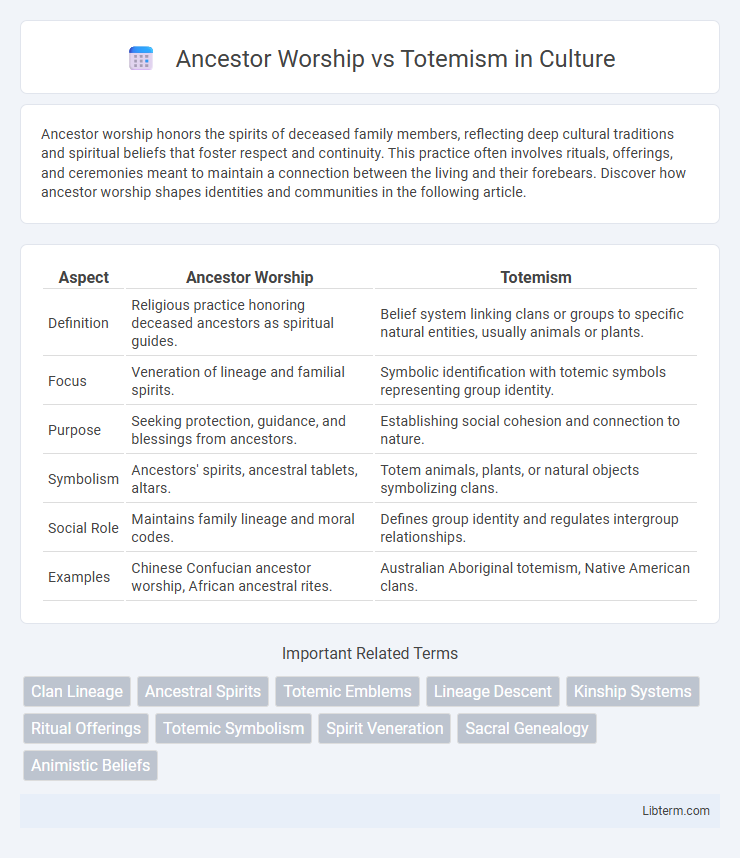Ancestor worship honors the spirits of deceased family members, reflecting deep cultural traditions and spiritual beliefs that foster respect and continuity. This practice often involves rituals, offerings, and ceremonies meant to maintain a connection between the living and their forebears. Discover how ancestor worship shapes identities and communities in the following article.
Table of Comparison
| Aspect | Ancestor Worship | Totemism |
|---|---|---|
| Definition | Religious practice honoring deceased ancestors as spiritual guides. | Belief system linking clans or groups to specific natural entities, usually animals or plants. |
| Focus | Veneration of lineage and familial spirits. | Symbolic identification with totemic symbols representing group identity. |
| Purpose | Seeking protection, guidance, and blessings from ancestors. | Establishing social cohesion and connection to nature. |
| Symbolism | Ancestors' spirits, ancestral tablets, altars. | Totem animals, plants, or natural objects symbolizing clans. |
| Social Role | Maintains family lineage and moral codes. | Defines group identity and regulates intergroup relationships. |
| Examples | Chinese Confucian ancestor worship, African ancestral rites. | Australian Aboriginal totemism, Native American clans. |
Introduction to Ancestor Worship and Totemism
Ancestor worship centers on veneration of deceased family members believed to influence the living's fortune. Totemism involves a symbolic relationship between a group and a totem, often an animal or plant, regarded as a spiritual emblem. Both practices serve social cohesion and spiritual identity within different cultural contexts.
Defining Ancestor Worship
Ancestor worship involves reverence for deceased family members believed to influence the living's fate, often incorporating rituals, offerings, and prayers to maintain harmony and seek guidance. It emphasizes direct lineage connections and the continuation of family legacy through spiritual veneration. This contrasts with totemism, where symbolic animals or natural elements represent a group's identity without necessarily involving familial ancestors.
Understanding Totemism
Totemism is a spiritual system that establishes a symbolic relationship between a social group and a particular natural entity, often an animal or plant, regarded as an emblem or ancestor. Unlike ancestor worship, which centers on reverence for deceased forebears, totemism integrates the natural world into social identity and kinship structures, influencing rituals, taboos, and social organization. Understanding totemism requires examining its role in cultural cohesion, ecological knowledge, and the embodiment of collective ancestry within the human-nature nexus.
Historical Origins and Evolution
Ancestor worship originated in ancient societies as a means to honor deceased family members, emphasizing lineage and familial continuity, while totemism emerged primarily among tribal communities, symbolizing spiritual connections between humans and natural entities like animals or plants. Historically, ancestor worship evolved through formal rituals and offerings that reinforced social hierarchies and cultural identity, whereas totemism developed as a system of clan or tribal identification with mythological significance tied to specific totems. Over time, these practices influenced religious developments by integrating ancestral reverence and symbolic kinship, shaping early belief systems and social structures across different civilizations.
Core Beliefs and Practices
Ancestor worship centers on venerating deceased family members, believing they influence the living's fortune and well-being through rituals, offerings, and prayers. Totemism involves identifying a clan or group with a particular animal or natural symbol, which serves as a spiritual emblem and guardian, often reflected in taboos and social organization. Both practices emphasize connection with non-human entities, but ancestor worship focuses on lineage spirits, while totemism highlights a mystical bond with nature-based symbols.
Symbols and Rituals
Ancestor worship employs symbols such as ancestral tablets and spirit tablets to honor deceased family members, with rituals involving offerings, prayers, and ancestral rites to maintain a connection with the lineage. Totemism centers on natural symbols like animals, plants, or natural objects considered sacred emblems of a clan or tribe, featuring rituals that include totemic ceremonies, dances, and taboos to reinforce group identity and spiritual bonds. Both practices use symbolic representation and ritualistic acts to foster community cohesion and spiritual continuity, yet ancestor worship focuses on personal lineage while totemism emphasizes collective kinship with natural elements.
Social and Cultural Functions
Ancestor worship reinforces social cohesion by promoting lineage-based identity and moral obligations within families, serving as a framework for social order and continuity. Totemism functions as a system of social classification and group identity, where clans or tribes identify with specific natural symbols, fostering solidarity and regulating social behavior. Both practices embed cultural values and norms, but ancestor worship centers on familial reverence while totemism emphasizes collective tribal affiliation.
Geographic Distribution
Ancestor worship predominantly occurs in East Asian cultures, including China, Japan, and Korea, where familial lineage and filial piety are deeply rooted in social and religious practices. Totemism is more commonly found among Indigenous peoples of Australia, parts of Africa, and Native American tribes, where clans or groups identify with specific animals or natural objects as spiritual emblems. The geographic distribution of these beliefs reflects distinct cultural environments: ancestor worship centers on ancestral veneration in agrarian societies, while totemism emphasizes a symbolic relationship with nature in tribal and animistic communities.
Key Differences Between Ancestor Worship and Totemism
Ancestor worship centers on venerating deceased family members believed to influence the living's well-being, while totemism involves a spiritual connection between a group and a specific animal, plant, or object symbolizing their identity. Ancestor worship emphasizes lineage and familial ties, with rituals aimed at honoring and seeking guidance from ancestors. Totemism is more collective, focusing on clan or tribal identities and taboos associated with the totemic entity rather than individual ancestors.
Contemporary Relevance and Influence
Ancestor worship remains influential in many East Asian and African cultures, shaping social values, family structures, and spiritual practices by emphasizing respect for lineage and continuity. Totemism persists among Indigenous communities in Australia, North America, and Africa, fostering group identity and environmental stewardship through symbolic animal or natural emblems. Both practices contribute to contemporary cultural resilience, community cohesion, and the preservation of intangible heritage in increasingly globalized societies.
Ancestor Worship Infographic

 libterm.com
libterm.com